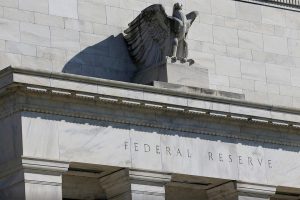WASHINGTON — The US Federal Reserve can be “prudent” in deciding when to cut its benchmark interest rate, with a strong economy allowing central bankers time to build confidence inflation will continue falling, Fed chair Jerome Powell told the CBS news show “60 Minutes” in an interview that aired Sunday night.
“The prudent thing to do is…to just give it some time and see that the data confirm that inflation is moving down to 2% in a sustainable way,” Mr. Powell said. “We want to approach that question carefully,” with the economy’s current strength keeping the risk of recession reduced as policymakers wait for the final bits of data that will convince them to proceed with rate cuts.
The interview took place on Thursday, before a blowout January jobs report on Friday showed firms added 353,000 new positions, with continued strong wage growth and 3.7% unemployment that has barely budged in two years.
The United States’ sustained recovery amid falling inflation has seemed to put the Fed on the verge of what Powell characterized as a “historically unusual” situation, though he refrained from saying that a “soft-landing” was now all but assured.
Indeed he said the Fed was watching risks to both its price stability and maximum employment mandates, and would consider weakening job growth as a possible reason to accelerate rate cuts.
“We’re focused on the real economy and doing the right thing for the economy and for the American people over the medium and long term,” Mr. Powell said. “We have to balance the risk of moving too soon…or too late.”
“IN A GOOD PLACE”
Fed chairs, covered intently by the financial press worldwide, occasionally use appearances on popular and widely available shows to flag turning points in policy or to take note of major developments. Mr. Powell did so at the start of the pandemic to reassure the public that the central bank stood behind the economy.
In this case the message was a positive one of falling inflation, strong employment, and a coming easing of credit conditions — all without the “pain” that Mr. Powell had earlier warned was in store for households as the Fed contained the worst outbreak of inflation in 40 years.
“We think the economy’s in a good place. We think inflation is coming down. We just want to gain a little more confidence that it’s coming down in a sustainable way toward our 2% goal,” he said.
The Fed’s preferred measure of inflation, the personal consumption expenditures price index, was running at a 2.6% annual rate as of December, though over shorter three- and six-month horizons it has been below the Fed’s target.
In the wide-ranging conversation, the Fed chair reiterated many of the comments made at his press conference last week after the Fed held its benchmark interest rate steady in the current range of between 5.25% and 5.5%. This included his view that the next Fed meeting in March was likely too soon for rate cuts to begin.
An outside shock could always throw the economy off course, he said, listing the world’s current set of geopolitical crises. Yet even some potential economic trouble spots, like China’s real estate problems and slowing growth rate, may have less impact on the US than might be expected.
“Our financial system is not deeply intertwined with theirs…Our production systems are not deeply intertwined with theirs,” Mr. Powell said. “The implications for the United States — we may feel them a bit, but they shouldn’t be that large.”
Absent some unexpected development, the start of rate cuts “is really going to depend on the data,” Mr. Powell said.
Asked about Fed policymaker projections in December that anticipate three quarter point rate cuts this year, the Fed chair said that “nothing has happened in the meantime that would lead me to think that people would dramatically change their forecasts.” — Reuters





